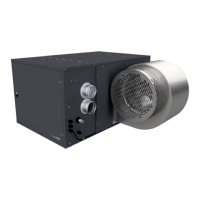page no. 30 of 68
LX Range Users, Installation & Servicing Instructions Doc Ref M110 issue 1.0 Dec 2020.
2.1.5. Gas Connection
Gas Safety (Installation & Use) (Amendment)
Regulations
It is law that the final connection to all gas
appliances are achieved by qualified
persons* in accordance with the current
issue of the above regulations. Failure to
install appliances correctly can lead to prosecution. It is
in your own interests and that of safety to ensure that
the law is complied with.
* An approved class of person listed on the gas safe
register.
• A servicing valve and union must be fitted at the gas inlet
to the heater to facilitate servicing.
• The gas supply to the air heater must be completed in
solid pipe work and be adequately supported.
• Heaters suspended by drop rods, straps or chains must
have a flexible connection as the final link between the gas
supply pipe work and the heater. Sufficient slack must be
left in the connection to take account of normal movement
of the heater.
Warning:
When completing the final gas connection to
the heater do not place undue strain on the
gas pipe work of the heater.
2.1.6. Electrical Connections
Warning: Wiring external to the unit must be
carried out by an appropriately qualified
person to current IEE regulations for
Electrical Installations and any local
regulations which apply.
All units are fully pre-wired and only require final
connection of the incoming mains supply and completion
of the control circuit (230V) via a controller, room
thermostat, time clock etc.
All electrical connections are made to the terminals in
the control section and should be in accordance with the
terminal markings and the wiring diagram for the heater.
All heaters must be earthed.
The electrical supply must be run to a point adjacent
to the heater and be suitably terminated to provide an
isolation point that will prevent remote activation of the
unit during servicing. See section 1.2 to ascertain the
electrical loading of the unit(s) so that cables of adequate
cross-sectional area are used for the electrical installation.
The length of the conductors between the cord anchorage
and the terminals must be such that the current carrying
conductors become taut before the earth conductor if the
cable or cord slips out of the cord anchorage. All external
controls must be of an approved type.
2.1.7. Controller/Thermostat Siting
If a remote room thermostat, or controller with an integral
sensor, is used it should be fitted at a point which will
be generally representative of the heated area as far
as temperature is concerned. Draughty areas, areas
subjected to direct heat e.g. from the sun, and areas
where the air movement is relatively stagnant e.g. in
recesses, should be avoided. The temperature controller/
room thermostat should be mounted approximately 1.5m
from the floor. Any room thermostat, frost thermostat
must be suitable for switching 230V, 5A and must be of
the 'snap action' type to minimise contact bounce.
2.1 Fitting the Unit

